#Sanātana Dharma
Text
I almost forgot! Darshan of the Ayodhya Ram Mandir! Ram Lalla's idol - Jai Shree Ram!! Ram Ram!

(Photo Credit: X Link)


(Photo Credit: Facebook)
#things i need to post about more. 1. q.ueer stuff 2. hindu stuff 3. see one and two#looK!!! look at Him!!!!#Hinduism#Rama#Sri Ram#Ayodhya#ram mandir#Sanatan Dharma#Sanātana Dharma#hindublr
35 notes
·
View notes
Text
its really frustrating that nearly every resource to learn about Hindu topics like yoga, āyurveda, chakras, tantra, etc. seems to be from new age sources that have no grounding in actual Hinduism at all, and it makes it extremely difficult to access information on actual Hinduism
i hate how appropriated Hindu practices are the first (often only) thing that you see when you try to research the authentic material is new age bastardizations of Hindu practices
10 notes
·
View notes
Text
The Road to Dharma
0 notes
Text
सनातन धर्म में कौन कौन आते हैं?
सनातन धर्म में कौन कौन आते हैं?
सनातन धर्म को हम जैसा समझते हैं, वो वैसा बिलाकुल भी नहीं हैं। हम ऐसा लगता है।
की सनातन धर्म में बस हिंदू ही आते हैं। लकिन ये बिलाकुल भी सत्य नहीं है? यद्यपि आज सनातन का पराया हिंदू से हैं।
यहां से ऐसा नहीं है, सनातन धर्म में सिख, बौद्ध, जैन धर्मावलंबी भी सनातन धर्म का हिसा है,
इसली ये बोलना गलत होगा की एक हिंदू धर्म से ही सनातन धर्म है, सनातन धर्म से ही सनातन धर्म है। .
ये सब धर्म सनातनी ही…

View On WordPress
#Bhiwani#Dharma#Hinduism#Hindus#History#home#Marathi language#Navagraha#Quotation#Sanatan Dharam Sanskrit Mahavidyalaya#Sanātana Dharma#shopsalary#The Companions & Co.#धर्म#हिंदू#हिन्दू धर्म#धर्मावलंबी#बौद्ध#सनातन धर्म#सिख
0 notes
Text
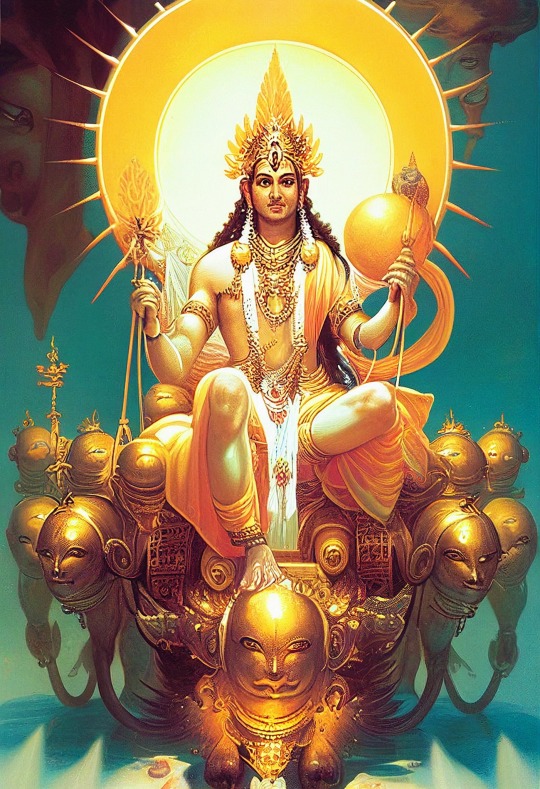
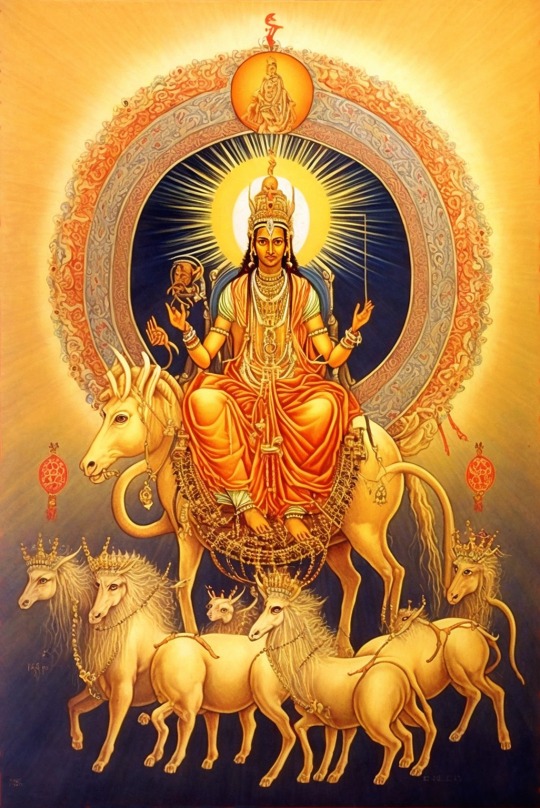
Lord Surya and his Chariot ☀️
Talon Abraxas
Symbolism And Significance Of The Seven Horses Surya - Sun God in Hinduism
Lord Surya is the sun god in Hinduism. Important scriptures and mythology associated with Hindu religion contains several depiction of Lord Surya riding seven horses. The seven horses are known as Harits. Ratha Saptami is an important festival dedicated to Lord Surya riding seven horses.
In Hindu Mythology, Lord Surya rides across the heavens (sky) in a chariot drawn by seven horses. The horses symbolize the cosmic rays, which radiates warmth and life. As they move across the skies, they remove darkness and usher in light. The seven horses also symbolize the seven colors of rainbow.
The reins of the horses are firmly in the hands of Aruna (Charioteer of Sun God). The reins are the seasons and Aruna makes sure with the reins that rays of the sun sustain all living beings. The seven horses are also said to represent the seven days of the week.
The seven horses are often referred as Harits and sometimes instead of horses it is seven mares. Occasionally, they are also depicted as one horse or mare with seven heads.
19 notes
·
View notes
Note
Is Engels woman coded?
Engels is pure shakti, an incarnation of Saraswati amma, hence that one picture he drew of the woman and his whole Liszt thing. Sanātana Marxist dharma
8 notes
·
View notes
Photo
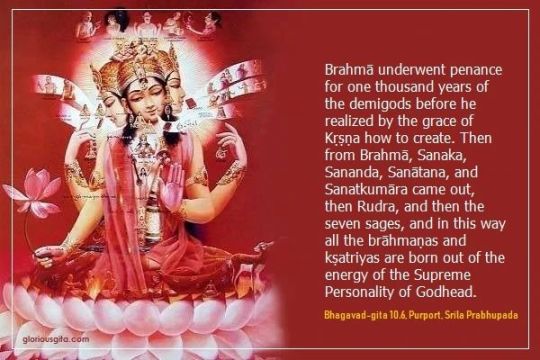
महर्षयः सप्त पूर्वे चत्वारो मनवस्तथा | मद्भावा मानसा जाता येषां लोक इमाः प्रजाः || ६ || maharṣayaḥ sapta pūrve catvāro manavas tathā mad-bhāvā mānasā jātā yeṣāṁ loka imāḥ prajāḥ The seven great sages and before them the four other great sages and the Manus progenitors of mankind are born out of My mind, and all creatures in these planets descend from them. The Lord is giving a genealogical synopsis of the universal population. Brahmā is the original creature born out of the energy of the Supreme Lord, who is known as Hiraṇyagarbha. And from Brahmā all the seven great sages, and before them four other great sages, named Sanaka, Sananda, Sanātana and Sanat-kumāra, and the fourteen Manus, are manifested. All these twenty-five great sages are known as the patriarchs of the living entities all over the universe. There are innumerable universes and innumerable planets within each universe, and each planet is full of population of different varieties. All of them are born of these twenty-five patriarchs. Brahmā underwent penance for one thousand years of the demigods before he realized by the grace of Kṛṣṇa how to create. Then from Brahmā came Sanaka, Sananda, Sanātana and Sanat-kumāra, then Rudra, and then the seven sages, and in this way all the brāhmaṇas and kṣatriyas are born out of the energy of the Supreme Personality of Godhead. Brahmā is known as Pitāmaha, the grandfather, and Kṛṣṇa is known as Prapitāmaha, the father of the grandfather. That is stated in the Eleventh Chapter of the Bhagavad-gītā (11.39). https://gloriousgita.com/verse/en/10/6 https://vedabase.io/en/library/bg/10/6/ https://bookchanges.com/wp-content/uploads/2009/09/Bg-Chapter-10-diff.htm https://youtube.com/c/HearSrilaPrabhupada https://www.bhagavad-gita.us/famous-reflections-on-the-bhagavad-gita/ https://sites.google.com/view/sanatan-dharma https://m.facebook.com/HDG.A.C.Bhaktivedanta.Svami.Srila.Prabhupada.Uvaca/ #bhagavatam #srimadbhagavatam #vishnu #vishnupuran #harekrishna #harekrsna #harekrishna #harekrisna #prabhupada #bhagavadgita #bhagavadgitaasitis #bhagavadgītā #srilaprabhupada #srilaprabhupad #srilaprabhupadaquotes #asitis #india #indian #wayoflife #religion #goals https://www.instagram.com/p/Co_Z_hMIGTG/?igshid=NGJjMDIxMWI=
#bhagavatam#srimadbhagavatam#vishnu#vishnupuran#harekrishna#harekrsna#harekrisna#prabhupada#bhagavadgita#bhagavadgitaasitis#bhagavadgītā#srilaprabhupada#srilaprabhupad#srilaprabhupadaquotes#asitis#india#indian#wayoflife#religion#goals
2 notes
·
View notes
Text
youtube
How Adi Shankaracharya Revived the Lost Glory of Sanātana Dharma
Hello friends, welcome to the episode number 37 of Hyper Quest. Friends, in today's episode we will learn about the personality without whom Sanatan Dharma cannot be imagined. If the Pope is the religious leader of Christians and the Dalai Lama of Buddhists, then Jagatguru Adi Shankaracharya is the religious leader of Sanatana, who united the whole of India on the Vedic platform by reviving the Sanatan Dharma which was headed towards extinction. If you do not know about Adi Shankaracharya then unfortunately you do not know anything about Sanatana Hindu Dharma.
1 note
·
View note
Text
శ్రీమద్భగవద్గీత - 432 : 11వ అధ్., శ్లో 18 / Bhagavad-Gita - 432: Chap. 11, Ver. 18

🌹. శ్రీమద్భగవద్గీత - 432 / Bhagavad-Gita - 432 🌹
✍️. శ్రీ ప్రభుపాద, 📚. ప్రసాద్ భరద్వాజ
🌴. 11వ అధ్యాయము - విశ్వరూప సందర్శన యోగం - 18 🌴
18. త్వమక్షరం పరమం వేదితవ్యం త్వమస్య విశ్వస్య పరం నిధానమ్ |
త్వమవ్యయ: శాశ్వతధర్మగోప్తా సనాతనస్త్వం పురుషో మతో మే ||
🌷. తాత్పర్యం : దివ్యమైన ఆదిధ్యేయము నీవే. విశ్వమంతటికిని పరమాధారము నీవే. అవ్యయుడవు మరియు సనాతనుడవు నీవే. నీవే శాశ్వతధర్మమును రక్షించు దేవదేవుడవు. ఇదియే నా అభిప్రాయము.
🌷. భాష్యము :
🌹 🌹 🌹 🌹 🌹
🌹 Bhagavad-Gita as It is - 432 🌹
✍️ Sri Prabhupada, 📚 Prasad Bharadwaj
🌴 Chapter 11 - Viswaroopa Sandarsana Yoga - 18 🌴
18. tvam akṣaraṁ paramaṁ veditavyaṁ tvam asya viśvasya paraṁ nidhānam
tvam avyayaḥ śāśvata-dharma-goptā sanātanas tvaṁ puruṣo mato me
🌷 Translation : You are the supreme primal objective. You are the ultimate resting place of all this universe. You are inexhaustible, and You are the oldest. You are the maintainer of the eternal religion, the Personality of Godhead. This is my opinion.
🌹 Purport :
.
🌹 🌹 🌹 🌹 🌹
1 note
·
View note
Text
🌹 23, SEPTEMBER 2023 SATURDAY ALL MESSAGES శనివారం, స్థిర వాసర సందేశాలు 🌹
🍀🌹 23, SEPTEMBER 2023 SATURDAY ALL MESSAGES శనివారం, స్థిర వాసర సందేశాలు 🌹🍀
1) 🌹 23, SEPTEMBER 2023 SATURDAY శనివారం, స్థిర వాసరే, నిత్య పంచాంగము Daily Panchangam🌹
2) 🌹. శ్రీమద్భగవద్గీత - 432 / Bhagavad-Gita - 432 🌹
🌴. 11వ అధ్యాయము - విశ్వరూప సందర్శన యోగం - 18 / Chapter 11 - Viswaroopa Sandarsana Yoga - 18 🌴
3) 🌹 . శ్రీ శివ మహా పురాణము - 793 / Sri Siva Maha Purana - 793 🌹
🌻. గణాధ్యక్షుల యుద్ధము - 4 / Description of the Special War - 4 🌻
4) 🌹. ఓషో రోజువారీ ధ్యానాలు - 45 / Osho Daily Meditations - 45 🌹
🍀 46. గందరగోళం / 46. CONFUSION 🍀
5) 🌹. శ్రీ లలితా చైతన్య విజ్ఞానము - 484 - 8 / Sri Lalitha Chaitanya Vijnanam - 484 - 8 🌹
🌻 484. 'డాకినీశ్వరీ' - 8 / 484. 'Dakinishwari' - 8 🌻
🍀🌹🍀🌹🍀🌹🍀🌹🍀🌹
🍀🌹🍀🌹🍀🌹🍀🌹🍀🌹
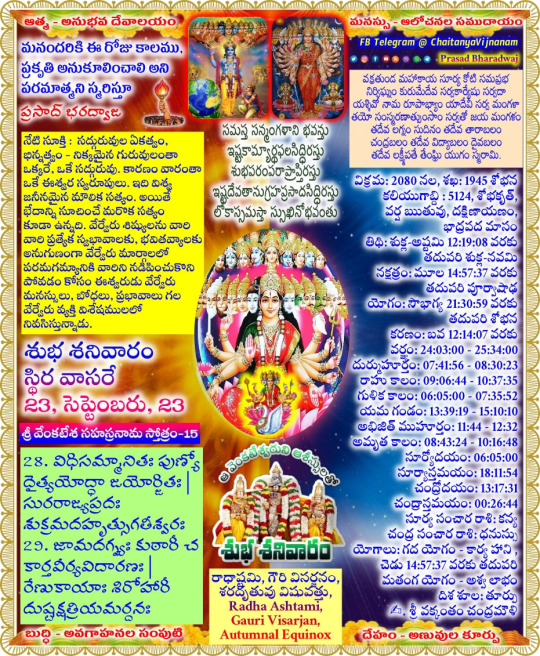
🌹 23, సెప్టెంబరు, SEPTEMBER 2023 పంచాంగము - Panchangam 🌹
శుభ శనివారం, Saturday, స్థిర వాసరే
మనందరికి ఈ రోజు కాలము, ప్రకృతి అనుకూలించాలి అని పరమాత్మని స్మరిస్తూ - ప్రసాద్ భరద్వాజ
🌻. పండుగలు మరియు పర్వదినాలు : రాధాష్టమి, గౌరి విసర్జనం, శరదృతువు విషువత్తు, Radha Ashtami, Gauri Visarjan, Autumnal Equinox 🌻
🍀. శ్రీ వేంకటేశ సహస్రనామ స్తోత్రం - 15 🍀
28. విధిసమ్మానితః పుణ్యో దైత్యయోద్ధా జయోర్జితః |
సురరాజ్యప్రదః శుక్రమదహృత్సుగతీశ్వరః
29. జామదగ్న్యః కుఠారీ చ కార్తవీర్యవిదారణః |
రేణుకాయాః శిరోహారీ దుష్టక్షత్రియమర్దనః
🌻 🌻 🌻 🌻 🌻
🍀. నేటి సూక్తి : సద్గురువుల ఏకత్వం, భిన్నత్వం - నిక్కమైన గురువులంతా ఒక్కరే, ఒకే సద్గురువు. కారణం వారంతా ఒకే ఈశ్వర స్వరూపులు. ఇది విశ్వజనీనమైన మౌలిక సత్యం. అయితే భేదాన్ని సూచించే మరొక సత్యం కూడా ఉన్నది. వేర్వేరు శిష్యులను వారి వారి ప్రత్యేక స్వభావాలకు, భవితవ్యాలకు అనుగుణంగా వేర్వేరు మార్గాలలో పరమగమ్యానికి వారిని నడిపించుకొని పోవడం కోసం ఈశ్వరుడు వేర్వేరు మనస్సులు, బోధలు, ప్రభావాలు గల వేర్వేరు వ్యక్తి విశేషములలో నివసిస్తున్నాడు.🍀
🌷🌷🌷🌷🌷
విక్రమ: 2080 నల, శఖ: 1945 శోభన
కలియుగాబ్ది : 5124, శోభకృత్,
వర్ష ఋతువు, దక్షిణాయణం,
భాద్రపద మాసం
తిథి: శుక్ల-అష్టమి 12:19:08 వరకు
తదుపరి శుక్ల-నవమి
నక్షత్రం: మూల 14:57:37 వరకు
తదుపరి పూర్వాషాఢ
యోగం: సౌభాగ్య 21:30:59 వరకు
తదుపరి శోభన
కరణం: బవ 12:14:07 వరకు
వర్జ్యం: 24:03:00 - 25:34:00
దుర్ముహూర్తం: 07:41:56 - 08:30:23
రాహు కాలం: 09:06:44 - 10:37:35
గుళిక కాలం: 06:05:00 - 07:35:52
యమ గండం: 13:39:19 - 15:10:10
అభిజిత్ ముహూర్తం: 11:44 - 12:32
అమృత కాలం: 08:43:24 - 10:16:48
సూర్యోదయం: 06:05:00
సూర్యాస్తమయం: 18:11:54
చంద్రోదయం: 13:17:31
చంద్రాస్తమయం: 00:26:44
సూర్య సంచార రాశి: కన్య
చంద్ర సంచార రాశి: ధనుస్సు
యోగాలు: గద యోగం - కార్య హాని ,
చెడు 14:57:37 వరకు తదుపరి
మతంగ యోగం - అశ్వ లాభం
దిశ శూల: తూర్పు
✍️. శ్రీ వక్కంతం చంద్రమౌళి
🌻 🌻 🌻 🌻 🌻
🍀. నిత్య ప్రార్థన 🍀
వక్రతుండ మహాకాయ సూర్యకోటి సమప్రభ
నిర్విఘ్నంకురుమేదేవ సర్వకార్యేషు సర్వదా
యశ్శివో నామ రూపాభ్యాం యాదేవీ సర్వ మంగళా
తయో సంస్మరణాత్పుంసాం సర్వతో జయ మంగళం
తదేవ లగ్నం సుదినం తదేవ తారాబలం చంద్రబలం తదేవ
విద్యాబలం దైవబలం తదేవ లక్ష్మీపతే తేంఘ్రి యుగం స్మరామి.
🌹🌹🌹🌹🌹
🍀🌹🍀🌹🍀🌹🍀🌹🍀🌹
🍀🌹🍀🌹🍀🌹🍀🌹🍀🌹
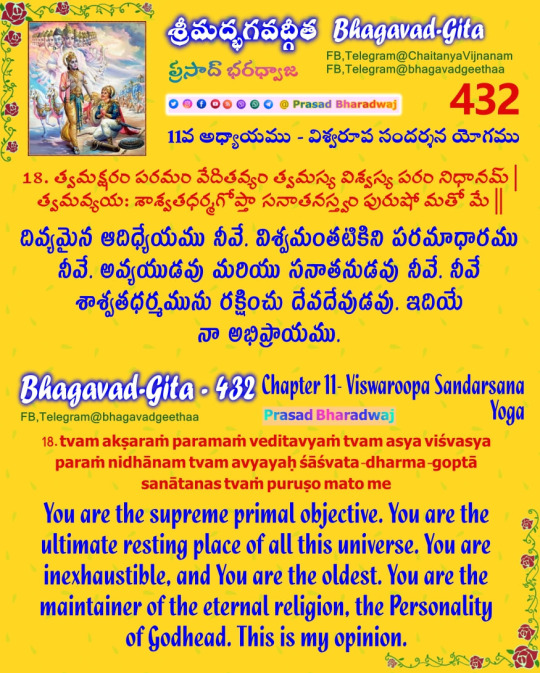
🌹. శ్రీమద్భగవద్గీత - 432 / Bhagavad-Gita - 432 🌹
✍️. శ్రీ ప్రభుపాద, 📚. ప్రసాద్ భరద్వాజ
🌴. 11వ అధ్యాయము - విశ్వరూప సందర్శన యోగం - 18 🌴
18. త్వమక్షరం పరమం వేదితవ్యం త్వమస్య విశ్వస్య పరం నిధానమ్ |
త్వమవ్యయ: శాశ్వతధర్మగోప్తా సనాతనస్త్వం పురుషో మతో మే ||
🌷. తాత్పర్యం : దివ్యమైన ఆదిధ్యేయము నీవే. విశ్వమంతటికిని పరమాధారము నీవే. అవ్యయుడవు మరియు సనాతనుడవు నీవే. నీవే శాశ్వతధర్మమును రక్షించు దేవదేవుడవు. ఇదియే నా అభిప్రాయము.
🌷. భాష్యము :
🌹 🌹 🌹 🌹 🌹
🌹 Bhagavad-Gita as It is - 432 🌹
✍️ Sri Prabhupada, 📚 Prasad Bharadwaj
🌴 Chapter 11 - Viswaroopa Sandarsana Yoga - 18 🌴
18. tvam akṣaraṁ paramaṁ veditavyaṁ tvam asya viśvasya paraṁ nidhānam
tvam avyayaḥ śāśvata-dharma-goptā sanātanas tvaṁ puruṣo mato me
🌷 Translation : You are the supreme primal objective. You are the ultimate resting place of all this universe. You are inexhaustible, and You are the oldest. You are the maintainer of the eternal religion, the Personality of Godhead. This is my opinion.
🌹 Purport :
.
🌹 🌹 🌹 🌹 🌹
🍀🌹🍀🌹🍀🌹🍀🌹🍀🌹
🍀🌹🍀🌹🍀🌹🍀🌹🍀🌹
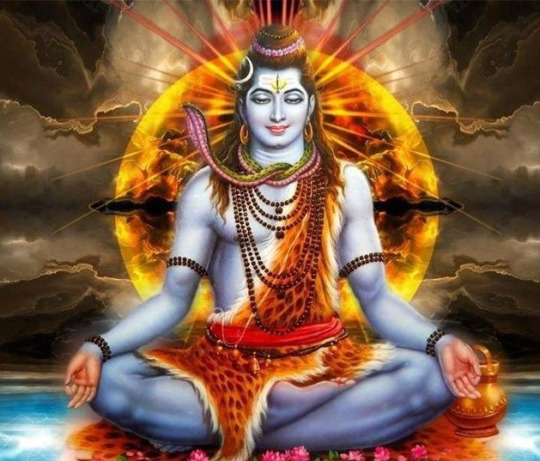
🌹 . శ్రీ శివ మహా పురాణము - 793 / Sri Siva Maha Purana - 793 🌹
✍️. స్వామి తత్త్వ విదానంద సరస్వతి 📚. ప్రసాద్ భరద్వాజ
🌴. రుద్రసంహితా-యుద్ద ఖండః - అధ్యాయము - 21 🌴
🌻. గణాధ్యక్షుల యుద్ధము - 4 🌻
*అపుడు నంది, మరియు గుహుడు వేగముగా యుద్దములోనికి ప్రవేవించి అవకాశము లేని విధముగా బాణపరంపరలతో రాక్షసులను ముంచెత్తి సంహరతించిరి (25). తెగ గొట్ట బడిన వారు, చితుక గొట్టబడినవారు, సంహరింపబడిన వారు, నేలగూలిన వారు మరియు భక్షింపబడినవారు అగు రాక్షసులతో ఆ స్తెన్యము అల్లకల్లోలమయ్యెను. స్తెన్యములో విషాదము అలుముకొనెను (26). ఈ తీరున భయంకరాకారుడు ప్రతాపవంత��డు అగు కుమారస్వామి, నంది, వీరభద్రుడు మరియు ఇతర గణములు ఆ యుద్ధములో అధికముగా గర్జించిరి (27). జలంధరుని సేనానాయకులగు నిశుంభ శుంభులు, మహాసురుడగు కాలనేమి మరియు ఇతర రాక్షసులు పరాజయమును పొందిరి (28).
అపుడు సముద్రపుత్రుడు, బలశాలి యగు జలంధరుడు తన సేన చెల్లాచెదరగుటను గాంచి, రెపరెపలాడు తున్న జెండా గల రథముప్తె నెక్కి గణముల వైపునకు వేగముగా వెళ్లెను (29). ఓ వ్యాసా! అపుడు పరాజితులై యున్న రాక్షసులు కూడా గొప్ప ఉత్సాహమును పొంది యుద్ధమునకు సన్నద్ధులై అధికముగా గర్జించిరి (30). నంది, కుమారస్వామి, గజాననుడు, వీరభద్రుడు మొదలుగా గల రుద్రగణములందరు కూడా జయోత్సాహము గలవారై, గర్జించిరి. ఓ మునీ! (31) రెండు సేనలలో గుర్రముల సకిలింపులు, ఏనుగుల ఘీంకారములు, రథముల ధ్వని, శంఖముల ధ్వని, భేరీల ధ్వని, మరియు సింహనాదములు మిన్ను ముట్టెను (32).*
సశేషం….
🌹 🌹 🌹 🌹 🌹
🌹 SRI SIVA MAHA PURANA - 793 🌹
*✍️ J.L. SHASTRI, 📚. Prasad Bharadwaj *
🌴 Rudra-saṃhitā (4): Yuddha-khaṇḍa - CHAPTER 21 🌴
🌻 Description of the Special War - 4 🌻
Nandin and Kārttikeya came hurriedly and struck the Daityas m the battle ground with incessant volleys of arrows.
Then the army of the Daityas became agitated and dejected with many Daityas wounded, split, killed, felled to the ground and devoured.
Thus Nandin, Kārttikeya the formidable and valorous, Vīrabhadra and the other Gaṇas roared much in the battle.
Then those two generals of the son of the ocean, Niśumbha and Śumbha, the great Daitya Kālanemi and the other Asuras were defeated.
On seeing the army destroyed, the powerful son of the ocean rushed at the Gaṇas in his chariot of waving and wafting colours.
Thereat even the defeated Daityas became jubilant. O Vyāsa, they roared much and got ready for the fray.
The victorious Gaṇas of Śiva too roared, led by Nandin, Kārttikeya, Gaṇeśa and Vīrabhadara, O sage.
The trumpets of the elephants, the neighing of the horses, the rumbling of the chariots, the sounds of the conches and war-drums and the leonine roars of the armies rose up.
Continues….
🌹🌹🌹🌹🌹
🍀🌹🍀🌹🍀🌹🍀🌹🍀🌹
🍀🌹🍀🌹🍀🌹🍀🌹🍀🌹

🌹. ఓషో రోజువారీ ధ్యానాలు - 46 / Osho Daily Meditations - 46 🌹
✍️. ప్రసాద్ భరద్వాజ
🍀 46. గందరగోళం 🍀
🕉. మీ స్థిర ఆలోచనలను వదలండి. అప్పుడు మీరు గందరగోళాన్ని మరింత ఆనందించగలరు. మరియు ఇది గందరగోళంగా ఉండదు - ఇది సృజనాత్మక గందరగోళంగా ఉంటుంది. మన హృదయంలో నక్షత్రాలు నర్తించాలంటే సృజనాత్మక గందరగోళం అవసరం. వేరే మార్గం లేదు. 🕉
మీకు స్థిరమైన ఆలోచనలు ఉంటే, జీవితం మీ కోసం చాలా గందరగోళాన్ని సృష్టిస్తుంది, ఎందుకంటే జీవితం మీ ఆలోచనలను ఎప్పుడూ నమ్మదు. ఇది విషయాలను గందరగోళానికి గురిచేస్తుంది. ఇది మీ విషయాలలో జోక్యం చేసుకుంటుంది. మాయలు ఆడుతూనే సాగుతుంది. ఇది మీ డ్రాయింగ్ రూమ్ లో ఫర్నిచర్ను సరిచేస్తే స్థిరంగా ఉన్నట్లు కాదు. ఇది చాలా విస్తారమైన ప్రక్రియ.దేవుడు చాలా అస్తవ్యస్తుడు. దేవుడు ఇంజనీర్ లేదా ఆర్కిటెక్ట్, శాస్త్రవేత్త లేదా గణిత శాస్త్రజ్ఞుడు కాదు. దేవుడు కలలు కనేవాడు, మరియు కలల ప్రపంచంలో, ప్రతిదీ గందరగోళంగా ఉంది. మీ ప్రియుడు అకస్మాత్తుగా గుర్రం అవుతాడు …. కలలో మీరు ఎప్పుడూ వాదించరు మరియు 'ఏం జరిగింది? ఒక్క క్షణం ముందు నువ్వు నా ప్రియుడిగా ఉండి ఇప్పుడు గుర్రం అయిపోయావు!' కలలో, మీరు అంగీకరిస్తారు.
ఏమి జరుగుతుందో అనే అనుమానం కూడా కలగదు, ఎందుకంటే కలలో మీరు మీ ఆలోచనలను మోసుకెళ్లరు. కానీ మీరు మేల్కొని ఉన్నప్పుడు మీ బాయ్ఫ్రెండ్ గుర్రంలా మారుతున్నట్లు చూడటం మీకు అసాధ్యం, మరియు బాయ్ఫ్రెండ్స్ చాలాసార్లు గుర్రాలుగా మారతారు! ముఖం అలాగే ఉండవచ్చు కానీ శక్తి భిన్నంగా ఉంటుంది. అప్పుడు మీరు గందరగోళంగా భావిస్తారు. అయోమయంలో ఉన్న వ్యక్తిని నేను ఎప్పుడూ చూడలేదు. నేను స్థిరమైన ఆలోచనలు ఉన్న వ్యక్తులను చూస్తాను. ఆలోచన ఎంత స్థిరంగా ఉంటే అంత గందరగోళం ఉంటుంది. మీరు గందరగోళంగా ఉండకూడదనుకుంటే, ఆలోచనను వదలండి - గందరగోళం మారుతుందని కాదు, కానీ అది గందరగోళంగా కనిపించదు. ఇది కేవలం జీవితం, సజీవమైనది.
కొనసాగుతుంది…
🌹 🌹 🌹 🌹 🌹
🌹 Osho Daily Meditations - 46 🌹
📚. Prasad Bharadwaj
🍀 46. CONFUSION 🍀
🕉. Drop your fixed ideas. Then you will be able to enjoy confusion more. And it will not be confusion--it will be creative chaos. We need a creative chaos in the heart to give birth to dancing stars. There is no other way. 🕉
If you have fixed ideas, life is going to create much confusion for you, because life never believes your ideas. It goes on muddling things. It goes on meddling with people. It goes on playing tricks. It is not a drawing room in which you fix your furniture and it remains the same. It is a very wild phenomenon. God is very chaotic. God is not an engineer or an architect, scientist or a mathematician. God is a dreamer, and in a world of dreams, everything is muddled. Your boyfriend suddenly becomes a horse …. In a dream you never argue and never say, "What has happened? Just a moment before you were my boyfriend and now you have become a horse!" In a dream, you accept.
Not even a suspicion about what is happening arises, because in a dream you don't carry your ideas. But while you are awake it will be impossible for you to see that your boyfriend is turning into a horse, And boyfriends many times turn into horses! The face may remain the same but the energy becomes different. Then you feel confused. I have never really come across any person who is confused. Rather I come across people who have fixed ideas. The more fixed the idea, the more confusion there will be. If you want to be unconfused, drop the idea-not that confusion will change, but it will not look like confusion at all. It is just life, alive.
Continues…
🌹 🌹 🌹 🌹 🌹
🍀🌹🍀🌹🍀🌹🍀🌹🍀🌹
🍀🌹🍀🌹🍀🌹🍀🌹🍀🌹
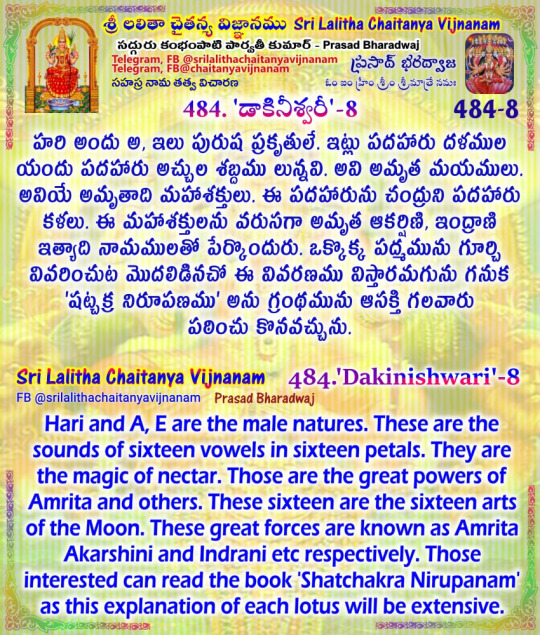
🌹. శ్రీ లలితా చైతన్య విజ్ఞానము - 484 - 8 / Sri Lalitha Chaitanya Vijnanam - 484 - 8 🌹
🌻. లలితా సహస్ర నామముల తత్వ విచారణ 🌻
✍️. సద్గురు శ్రీ కంభంపాటి పార్వతీ కుమార్
సేకరణ : ప్రసాద్ భరద్వాజ
🍁. మూల మంత్రము : ఓం ఐం హ్రీం శ్రీం శ్రీమాత్రే నమః 🍁
🍀 99. పాయసాన్నప్రియా, త్వక్స్థా, పశులోక భయంకరీ ।
అమృతాది మహాశక్తి సంవృతా, డాకినీశ్వరీ ॥ 99 ॥ 🍀
🌻 484. 'డాకినీశ్వరీ' - 8 🌻
హరి అందు అ, ఇలు పురుష ప్రకృతులే. ఇట్లు పదహారు దళముల యందు పదహారు అచ్చుల శబ్దము లున్నవి. అవి అమృత మయములు. అవియే అమృతాది మహాశక్తులు. ఈ పదహారును చంద్రుని పదహారు కళలు. ఈ మహాశక్తులను వరుసగా అమృత ఆకర్షిణి, ఇంద్రాణి ఇత్యాది నామములతో పేర్కొందురు. ఒక్కొక్క పద్మమును గూర్చి వివరించుట మొదలిడినచో ఈ వివరణము విస్తారమగును గనుక 'షట్చక్ర నిరూపణము' అను గ్రంథమును ఆసక్తి గలవారు పఠించు కొనవచ్చును.
సశేషం…
🌹 🌹 🌹 🌹 🌹
🌹 Sri Lalitha Chaitanya Vijnanam - 484 -8 🌹
Contemplation of 1000 Names of Sri Lalitha Devi
✍️ Prasad Bharadwaj
🌻 Payasanna priya tvaksdha pashuloka bhayankari
amrutadi mahashakti sanvruta dakinishvari ॥ 99 ॥ 🌻
🌻 484. 'Dakinishwari' - 8 🌻
Hari and A, E are the male natures. These are the sounds of sixteen vowels in sixteen petals. They are the magic of nectar. Those are the great powers of Amrita and others. These sixteen are the sixteen arts of the Moon. These great forces are known as Amrita Akarshini and Indrani etc respectively. Those interested can read the book 'Shatchakra Nirupanam' as this explanation of each lotus will be extensive.
Continues…
🌹 🌹 🌹 🌹 🌹
🍀🌹🍀🌹🍀🌹🍀🌹🍀🌹
🍀🌹🍀🌹🍀🌹🍀🌹🍀🌹
0 notes
Text
Hinduismo. Es una de las religiones más extendidas e importantes del mundo, no solo por su número de fieles (estimados en más de 800 millones de individuos), sino también por la profunda influencia que ha ejercido en muchas otras religiones durante su larga e ininterrumpida historia, que comenzó más o menos en el 1500 a. n. e.
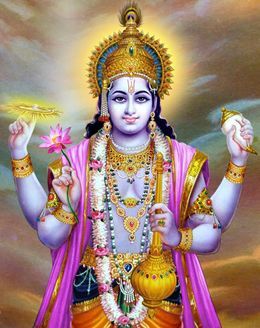
Historia
El hinduismo, una de las religiones originarias de la India ―siendo las otras el budismo, el yainismo y el sijismo― cuyos habitantes siguen profesándolas en la actualidad. Sus fieles las practican aún cuando hayan emigrado desde dicho país hacia el resto del mundo. No posee fundador, no es una religión homogénea ni una filosofía, sino un conjunto de creencias metafísicas, religiosas, cultos, ritos, principios morales y costumbres que conforman una tradición común, en la que no existen ni dogmas definidos, ni una organización central.
En lo que se llama «hinduismo» confluyen concepciones de la divinidad, del ser humano y del mundo diferentes y hasta contradictorias entre sí, conviviendo pacíficamente en una tradición religiosa común, llamada en sánscrito: sanātana dharma (religión eterna). Lo importante no son tanto los contenidos doctrinales, sino el comportamiento correcto, el rito correcto, la religiosidad bien vivida.
Esta religión ha recibido influencia de otras religiones pues tiene una extraordinaria capacidad para absorber e integrar elementos foráneos contribuyendo de forma notable al sincretismo de la religión y a la asimilación de una gran variedad de creencias y prácticas religiosas. Se le ha otorgado el carácter de sistema doctrinal y social el cual se extiende a todos los aspectos de la vida humana.
Etimología de la palabra
En una inscripción en idioma avéstico, de la época del gobierno del rey Darío I (en el 500 a. n. e.), se menciona la forma hindūś [jindúsh], que es la versión persa de la palabra sánscrita sindhu (‘río’, refiriéndose por antonomasia al gran río Indo). Los persas utilizaban ese nombre para referirse a aquellos que vivían en las tierras más allá (más al este) del río Indo. De allí proviene la palabra «hindú», de donde deriva el nombre de la religión hinduista. Cuando los musulmanes originarios de Persia y Asia Central conquistaron la India en el siglo XI, este nombre jindú se comenzó a utilizar también en la India.
Los hinduistas se definen a sí mismos como dharmis (‘religiosos’), vedis (‘aquellos que se rigen por los textos Veda’) o varnásrami (‘aquellos que se clasifican en [cuatro] castas [varna] y se rigen por las [cuatro] etapas de la vida [ásrama]’).
En el sentido estricto de la palabra, en español, «hindú» no significa lo mismo que «indio», a pesar de que muchas veces se confunde el primero con el segundo.
El término siempre se ha referido a la persona que profesa el hinduismo indistintamente de su nacionalidad, mientras que al nativo del país India (o Indostán) se le denomina indio o indostaní. No obstante, de acuerdo con lo establecido por la RAE (Real Academia Española), el término «hindú» se refiere tanto a la persona natural de la India como a la persona que profese el hinduismo.
El término «hinduista» se creó también para referirse a un contexto exclusivamente religioso. En algunos países de Hispanoamérica, debido a que la palabra «indio» se utiliza de manera peyorativa y equivocadamente para referirse a los nativos del continente americano, a veces se utiliza «hindú» como gentilicio de la persona nacida en la India. La RAE admite esto como válido, siempre y cuando no haya posibilidad de confusión (que podría representar una ofensa para los indostaníes musulmanes o de otras religiones).
Según las definiciones del Diccionario de la lengua española (de la RAE), «hindú» tiene dos significados:
adj. y com. De la India o relativo a este país asiático.
Seguidor del hinduismo: los hindúes son mayoría religiosa en la India.
El plural del adjetivo «hindú» es hindúes o hindús.
Principios fundamentales
Las normas del hinduismo se definen en relación con lo que las personas hacen: en el seno del hinduismo se encuentra una mayor uniformidad en las acciones que en las creencias.
Los hinduistas se dividen en cuatro castas, o estratos sociales bien definidos:
los brahmanes, sacerdotes
los ksatria (chatrías), guerreros y gobernantes
los vaisias, terratenientes, ganaderos y comerciantes
los sudras, peones que trabajaban por la comida y el techo, generalmente de piel más oscura, descendientes de las tribus locales conquistadas por los arios en la segunda mitad del II milenio a. n. e.
los parias, esclavos intocables, generalmente de piel negra, descastados.
Los hinduistas de las tres primeras clases recitan mentalmente el secreto himno gáiatri al amanecer, al mediodía y al atardecer.
Adoran mediante sencillos rituales ―basados en los complicados rituales de los templos― a Siva, Visnú y la diosa Devi, pero también adoran a otras deidades menores, como Ganesh, Kali, Suria.
Hay prácticas como el reverenciar a los brahmánes y a las vacas.
La prohibición de comer carne (en especial la de vaca).
Contraer matrimonio solo con un miembro de la misma casta (jati) con la esperanza de tener un heredero varón.
Cada individuo percibe un modelo para vivir que ha de seguir y que confiere orden y sentido a su vida. En el hinduismo no existe una jerarquía doctrinal ni eclesiástica, pero la complicada estratificación social, inseparable de la religión, da a cada persona la sensación de ocupar una posición dentro de este enorme grupo humano.
Doctrinas
El origen espiritual del hinduismo se encuentra en el Rig-veda (el texto más antiguo de la India, compuesto oralmente hacia el 1500 a. n. e.) por los llamados rishis (religiosos y poetas anónimos y más o menos míticos). A partir del Veda original, en los siguientes siglos de crearon otros tres Vedas ―el Sama-veda, el Iáyur-veda y el Atharva-veda― cuyos textos reversionan los himnos originales. Fueron compuestos de manera oral ―los indios no inventaron la escritura (que ya se utilizaba en otras civilizaciones más antiguas, como Antiguo Egipto y Sumeria) sino hasta el 500 a. n. e.― en sánscrito védico, el idioma sagrado de la India. Los himnos de los Vedas no contienen doctrina filosófica alguna, desconocen la reencarnación, la meditación y la liberación espiritual, ni hablan de un alma trascendente. El centro de la vida religiosa de las personas en la cultura védica se basaba en los sacrificios de animales (como vacas y cabras) a los dioses Indra, Varuna y Mitra.
En el himno «Purusha-sukta» del Rig-veda se presenta una versión muy pretérita (anterior al II milenio a. n. e.) de cómo fue creado el mundo, que posiblemente refiere a una época de sacrificios humanos. El mundo fue creado mediante la matanza cruenta de un dios primigenio, el Purusha, que en mitos posteriores fue olvidado. Los sacerdotes, después de matarlo, cortan sus partes de manera ritual y con ellas crean cada parte del mundo.
Los sacerdotes brahmanes no tenían ninguna doctrina filosófica: solo sabían de complicados rituales para matar a los animales. Los reyes y guerreros, en cambio, se pasaban de generación en generación ideas acerca de la existencia de un alma trascendente, y como respuesta a la pregunta sobre el bien y el mal, crearon la doctrina de la reencarnación.
En algún momento del siglo VII a. n. e. comenzó a difundirse entre los sabios ermitaños la idea de ahimsa ―que cuatro siglos más tarde daría pie a la creación del budismo por parte de Buda―, y se adosaron a los Vedas nuevos textos, los Upanishad, que no tenían forma de himnos y que presentaban preguntas y respuestas de estos grandes sabios con respecto a temas filosóficos. Gradualmente el ritualismo de los Vedas se dejó de lado, y la lengua en que se pronunciaban ―el sánscrito védico, que es parecido a los idiomas indoiranios como el avéstico― se fue transformando en el sánscrito clásico y en el prácrito.
Los Upanishad contienen el mensaje espiritual del hinduismo. Han guiado e inspirado a los hinduistas en los últimos 25 siglos, de acuerdo al consejo dado en sus versos:
Tomando como un arco el gran arma del Upanishad, debes de colocar sobre él una flecha afilada por la meditación, estirarlo con un pensamiento dirigido a la esencia de Aquello y penetrar, amigo mío, aquel imperecedero como el blanco.
Los Upanishads consideran que los dioses védicos son secundarios a un dios trascendente e incomprensible, el Brahman. Desde entonces, la base de todo el hinduismo es la idea de que la plétora de cosas y eventos que rodean al ser humano no son sino diferentes manifestaciones de esa realidad última. El Brahman es el concepto cohesionador que le da su carácter de unidad al hinduismo, a pesar de la adoración de variados dioses. Es la realidad final, la esencia interior (el alma) de todas las cosas. Es infinito y está más allá de cualquier concepto; no puede ser comprendido por el intelecto ni puede ser adecuadamente descrito con palabras:
Brahman, sin comienzo, supremo: más allá de lo que es y más allá de lo que no es. Incomprensible es aquella alma suprema, ilimitada, no nacida, que no puede racionalizarse, impensable.
El Bhagavad-guita (que son apenas unos capítulos del extenso libro épico-mitológico Majabhárata (del siglo III a. n. e.) describe tres caminos para lograr la realización religiosa:
el sendero de la actividad o karma (aquí se mencionan actos de sacrificio y rituales),
el sendero del conocimiento o gñana (la meditación upanisádica de la divinidad) y
el sendero de la devoción hacia Dios o bhakti, un ideal religioso que vino a combinar y a hacer de los otros dos senderos, una vía más trascendente.
Los Upanishad lograron conciliar el monismo vedántico con el politeísmo védico al crear el concepto de que todos los dioses individuales (de los que se dice son parte del sa-guna Brahman, ‘Dios con atributos’) están sometidos al espíritu universal (el nir-guna Brahman, ‘Dios sin atributos’), del cual emanan todos. Por lo tanto, la mayoría de los hinduistas rinde tributo (a través del bhakti) a dioses a quienes adoran en los rituales (a través del karma) y a los que entienden (por medio del gñana) como aspectos de la última realidad, el reflejo material del que todo lo que existe es una ilusión maya creada por Dios con mucho.
Dioses
El dios Brahmá, de cuatro cabezas, es el creador mítico del mundo.
La triple manifestación del Dios supremo, conocido como la trinidad hinduista (Trimurti), son Brahma, Visnú y Siva, creador, conservador y destructor respectivamente. Aunque estos son los dioses principales, el panteón hinduista cuenta con la increíble cifra de 330 millones de dioses. Cada dios posee múltiples avatares. Un avatar es una reencarnación del dios sobre la tierra.
A pesar de que los hinduistas reconocen la existencia e importancia de muchos dioses y semidioses, la mayoría de los fieles son, en primer lugar, devotos de un solo dios o diosa; entre estos, los más populares son Siva, Visnú y la Diosa (Devi).
El dios Visnú, de cuatro brazos.
Visnú: es el dios hinduista de la preservación y la bondad, es adorado como un dios que está en todas partes (dios supremo para sus adoradores), el dios de cuyo ombligo brotó una flor de loto, dando a luz al creador (Brahma). Visnú creó el Universo, separando el cielo de la tierra. También se le adora bajo la forma de muchos avatares, dioses que descienden al mundo (o encarnaciones, en un sentido aproximado). Muchos de ellos son animales que suelen aparecer en la iconografía hindú: el pez, la tortuga y el cerdo.
Shiva
Siva: encarna los aspectos aparentemente contradictorios del dios de los ascetas y del dios fálico, cuyo símbolo (el lingam o falo) constituye el punto central y sacrosanto de todos los templos dedicados a él y de todos los hogares de sus adoradores; se dice que su priapismo fue el resultado de su castración, con el consecuente culto de su símbolo fálico sin cuerpo. Además de esto, se dice que Siva se habría hecho presente en la Tierra bajo distintas formas humanas, animales y vegetales.
Nara-Simja, un avatar de Visnú como ‘hombre-león’, que destripó al demonio Jirania-Kashipú y lo devoró.
Buda, religioso ateo que luchó contra el hinduismo, y a quien los hinduistas convirtieron en un avatar secreto de Visnú que se encarnó con el fin de enseñarles una doctrina falsa a las personas piadosas nacidas en familias demoníacas).
Devi o Durga.
Rama, el rey-dios héroe del Ramaiana).
Krisna, el rey-pastor héroe, creado en el Majabhárata (300 a. n. e.) y desarrollado en el Bhágavata-purana (1100 n. e.). Según los visnuistas, Krisna es un avatar de Visnú, pero según los visnuistas de Bengala (o krisnaístas), Krisna es el dios original a partir del cual se produjeron Visnú y todos los avatares.
Devi (la ‘diosa’): en algunos mitos, Devi es la primera que propone el movimiento, la acción, liderando el grupo de dioses masculinos para que realicen las labores de creación y de destrucción. También se muestra como Durga, a la que nadie se puede acercar, quien en la gran batalla mata a Majisha, el demonio búfalo. En muchos cultos tántricos, a esta Diosa se la identifica con Kali.
También hay representaciones más pacíficas de la Diosa, generalmente bajo la forma de las esposas de los dioses más importantes: Muchas de las diosas locales de la India ―como Manasha (la diosa de las serpientes en Bengala) y Minakshi (en Madurai)― están casadas con dioses, mientras que a otras como Shitala, diosa de la viruela, se las rinde culto por sí mismas. Estas últimas diosas son temidas por sus indomables poderes y mal carácter, y por sus arranques de cólera.
Laksmi, la sumisa y dócil esposa de Visnú
Parvati, esposa de Siva e hija del monte Himalaya
Ganga, la gran diosa del río Ganges, a quien también se adora de manera independiente; se dice que es una de las esposas de Siva
Saraswati, la diosa de la música y de la literatura y esposa e hija del dios Brahmá, de cuatro cabezas; se la asocia con el río Saraswati.
Radha, la principal de las amantes del dios adolescente Krisna.
Hay algunos dioses menores que están incluidos en el panteón central porque se les identifica con los dioses más importantes o con sus hijos o amigos.
Hanuman (el dios mono): aparece en el Ramayana como el ingenioso asistente de Rama en el sitio de Lanka. Skanda (el general del ejército de los dioses) es hijo de Siva
Ganesh, el hombre elefante
Ganesha o Ganapati, es el dios con cabeza de elefante, dios de los escribas y mercaderes, quien ayuda a eliminar los obstáculos; es invocado fervorosamente al comienzo de cualquier negocio importante.
Cultos y ritos
Desde el más importante hasta el menos trascendente de los dioses hindúes es objeto de veneración tanto en ceremonias públicas como en el ámbito de la intimidad familiar. Dadas las bases sociales del hinduismo, los actos más importantes son aquellos en los que se incluyen ritos de paso (samskaras o sacramentos).
El nacimiento y cuando el niño come por primera vez comida sólida (arroz).
El primer corte de pelo (para un niño varón).
La purificación después de la primera menstruación (para una niña).
El matrimonio
La bendición para las embarazadas, para que tengan un hijo varón y para asegurar así un parto sin dificultades y que el niño sobreviva los seis primeros días después del nacimiento, que son los más peligrosos (para lo cual se encomiendan a Shashti, la diosa del Seis). Tradicionalmente a los niños de menos de dos años, en la medicina ayurvédica se les llama Kumara (‘muere fácil’, siendo ku: ‘fácil; y mara: ‘muere’).
Las últimas ceremonias son las de la muerte (cremación y, si es posible, que las cenizas sean esparcidas por el Ganges, el río sagrado).
La ofrenda anual a los antepasados muertos. De estos últimos, el más notable es el del pinda, una bola de arroz y de semillas de sésamo que entrega el hijo mayor del difunto, para que el fantasma de su padre pueda salir del limbo y renacer.
Como parte del ritual diario (por lo general realizado por la esposa, quien se supone tiene más poder para interceder ante los dioses).
Los hindúes ofrecen (puja) frutas y flores ante un pequeño altar instalado en la vivienda.
Ofrendas a serpientes locales, árboles o a espíritus oscuros (benevolentes y malévolos) que moran en su propio jardín, en cruces de caminos o en otros sitios del pueblo considerados mágicos.
Muchos poblados y ciudades de diferentes tamaños tienen templos donde los sacerdotes celebran ceremonias durante todo el día: rezan al amanecer y emiten ciertos tipos de sonidos para despertar al dios que es santo entre los santos (la garbagriha o casa matriz); lavan, visten y abanican al dios, lo alimentan y distribuyen los restos de la comida (prasada) entre sus fieles.
El templo también constituye un centro cultural donde se cantan canciones, se leen los textos sagrados en voz alta (tanto en sánscrito como en lengua común) y se celebran rituales al anochecer.
Por lo general, una vez al año y durante ciertos días especiales, la imagen del dios recorre todo el complejo de culto sobre unas magníficas carrozas de madera tallada (ratha).
Fieles hinduistas en el río Ganges.
Muchos lugares sagrados o santuarios, como el de Rishikesh en el Himalaya o el de Benarés en el río Ganges, son objeto del peregrinaje de fieles procedentes de todas las zonas de la India.
En Bengala, la visita que hace la diosa Durga a su familia y luego su retorno al lado de Siva, su marido, se celebra cada año en Durgapuja. Se reproducen imágenes de la diosa en papel maché, figuras a las que se les rinde culto por diez días, y que más tarde, en una dramática ceremonia que se celebra a medianoche, son arrojadas al río Ganges. Todo esto va acompañado del retumbar de tambores y la luz de las velas.
Algunos festivales se celebran en toda la India: Diwali, el festival de las luces a comienzos del invierno, y Joli, el carnaval de la primavera, en el que los diferentes miembros de todas las castas se mezclan, sueltan sus cabellos y se mojan unos a otros con cascadas de polvo rojo y agua, lo que probablemente simboliza la sangre que quizás utilizaban siglos atrás.
Fuentes
http://www.hinduismo.eu/
culturadelasreligiones.blogspot.com
blog.lasociedadgeografica.com
libreriasintesis.com
Normativa de privacidad
EcuRed
Exoneraciones
0 notes
Photo
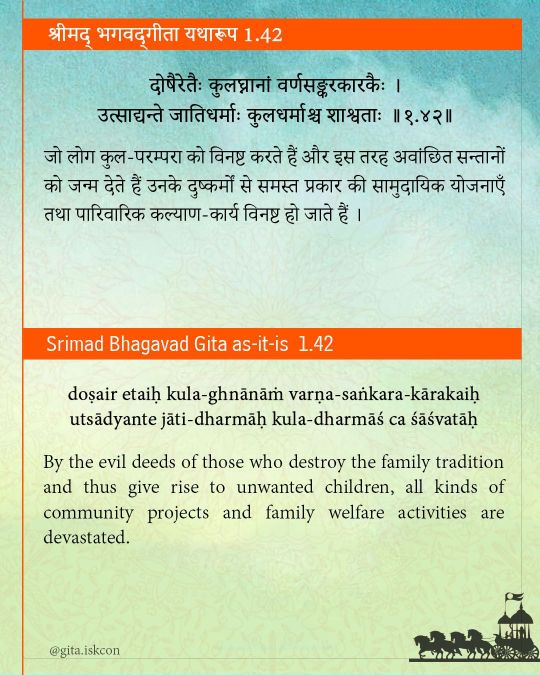
श्रीमद् भगवद्गीता यथारूप 1.42 https://srimadbhagavadgita.in/1/42 दोषैरेतैः कुलघ्नानां वर्णसङ्करकारकैः । उत्साद्यन्ते जातिधर्माः कुलधर्माश्च शाश्वताः ॥ १.४२ ॥ TRANSLATION जो लोग कुल-परम्परा को विनष्ट करते हैं और इस तरह अवांछित सन्तानों को जन्म देते हैं उनके दुष्कर्मों से समस्त प्रकार की सामुदायिक योजनाएँ तथा पारिवारिक कल्याण-कार्य विनष्ट हो जाते हैं । PURPORT सनातन-धर्म या वर्णाश्रम-धर्म द्वारा निर्धारित मानव समाज के चारों वर्णों के लिए सामुदायिक योजनाएँ तथा पारिवारिक कल्याण-कार्य इसलिए नियोजित हैं कि मनुष्य चरम मोक्ष प्राप्त कर सके । अतः समाज के अनुत्तरदायी नायकों द्वारा सनातन-धर्म परम्परा के विखण्डन से उस समाज में अव्यवस्था फैलती है, फलस्वरूप लोग जीवन के उद्देश्य विष्णु को भूल जाते हैं । ऐसे नायक अंधे कहलाते हैं और जो लोग इनका अनुगमन करते हैं वे निश्चय ही कुव्यवस्था की ओर अग्रसर होते हैं । ----- Srimad Bhagavad Gita As It Is 1.42 doṣair etaiḥ kula-ghnānāṁ varṇa-saṅkara-kārakaiḥ utsādyante jāti-dharmāḥ kula-dharmāś ca śāśvatāḥ TRANSLATION By the evil deeds of those who destroy the family tradition and thus give rise to unwanted children, all kinds of community projects and family welfare activities are devastated. PURPORT Community projects for the four orders of human society, combined with family welfare activities, as they are set forth by the institution of sanātana-dharma, or varṇāśrama-dharma, are designed to enable the human being to attain his ultimate salvation. Therefore, the breaking of the sanātana-dharma tradition by irresponsible leaders of society brings about chaos in that society, and consequently people forget the aim of life – Viṣṇu. Such leaders are called blind, and persons who follow such leaders are sure to be led into chaos. ----- #krishna #iskconphotos #motivation #success #love #bhagavatamin #india #creativity #inspiration #life #spdailyquotes #devotion
0 notes
Text
Hinduism
Hinduism (/ˈhɪnduɪzəm/) is an Indian religion or dharma, a religious and universal order or way of life by which followers abide. As a religion, it is the world's third-largest, with over 1.2–1.35 billion followers, or 15–16% of the global population, known as Hindus. The word Hindu is an exonym, and while Hinduism has been called the oldest religion in the world,[note 4] many practitioners refer to their religion as Sanātana Dharma (Sanskrit: सनातन धर्म ''the Eternal Dharma''), a modern usage, which refers to the idea that its origins lie beyond human history, as revealed in the Hindu texts. Another endonym is Vaidika Dharma, the dharma related to the Vedas.
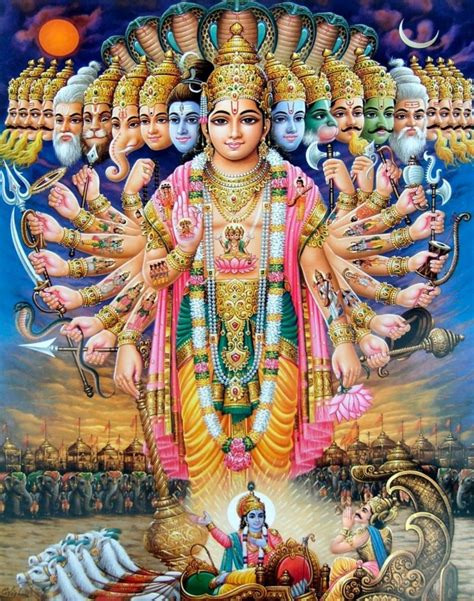


0 notes
Text
25 Amazing FACTS, not fiction for all those who consider Hinduism to be irrelevant, obsolete n unscientific! (2/2)
May 08, 2022
The original name in Sanskrit for Hinduism is Sanātana Dharma, which means the Eternal way of Salvation. The word Hindu or Indu comes from the Sanskrit word Sindhu, meaning a large body of water or River. It was coined by the Greeks to describe the people who lived around the Indus River in the Indus valley.
Sanskrit is one of the oldest languages in the world having a history of more than 3,500 years. Many linguists consider it to be the mother of many (almost all) languages. It belongs to the language family of Proto-Indo-Aryan, Proto-Indo-Iranian and Proto-Indo-Europian Languages. It is also been proven that Sanskrit is the most suitable language for computers.
Why is the German national Airlines called ✈"Lufthansa"✈ ? The word, Lufthansa is derived from the two Sanskrit Words,- 'Lupth' (लुप्त) & 'Hansa'(हंस) meaning, the Disappearing Swan (लुप्त हुआ हंस). When the German airline service first started commercial flights in 1926, the aircraft they employed in service were pure white, resembling huge white swans. When these aeroplanes would fly into the sky and slowly grow smaller and smaller before disappearing, they resembled large white swans, flying up, up and away before disappearing into the vastness of the sky. In Sanskrit, the phrase that could aptly describe them was ‘lupth-hansa’, (लुप्त हुआ हंस) or Luft-hansa,- the disappearing swan!
There Is No single founder of Hinduism Most religions have a founder such as Prophet Muhammad for Islam, Jesus for Christianity, Buddha for Buddhism, Mahavir for Jainism and so on. Hinduism, however, has no single founder and no one knows the exact timeline for when the oldest religion on Earth originated.
The Only Religion That Doesn’t Have A Conversion Rule Hinduism is the only religion that never invaded any country or other religion to convert them into Hindus. Hinduism has no rule or ritual for conversion. But it doesn’t restrict those who wish to practice it and attain salvation from embracing it.
The Hanuman Chalisa predicted the distance between Sun & Earth Hanuman Chalisa is a prayer offering to Lord Hanuman written by Santh Tulsidas in the 16th century. In a verse of this prayer, it’s written as follows,- “Yuga-Sahasra-yojana para Bhanu Leeloo Tahi Madhura Phala Janu” According to the above verse, the distance between the Sun and Earth is Yuga-Sahasra-yojana. As said by Hinduism, 1 yuga is 12,000 divine years, Sahasra means one thousand and Yojana means 8 miles. Now equating this calculation we get 12000 x 1000 x 8 = 96 mn miles, which is 154.4 mn kms approximately, much closer to the 20th-century calculation of 152 mn kms at Aphelion (Longest distance between the Sun and the Earth). WOW!
The Rig Veda is the oldest of the four Vedas It is the oldest Indian & one of the oldest Indo-European texts. On the basis of astronomical calculations, it is dated back to 8,000 years and some calculations date it back to 10,000 years. It is a religious text, composed in Sanskrit, that originated in ancient India (1,800-1,100 BCE.) The Rigveda is regarded as one of the most sacred texts of Hinduism. It has fascinated scholars and historians due to its significance and antiquity. It is a collection of ancient Vedic Sanskrit hymns.
Feel proud to be born a “Hindu”, live as a devout Hindu, inspire n create more Hindus n later, move on n seek moksha as a Hindu!
Jai Shri Ram! जय श्री राम! 🙏🏽
Ohm Namah Shivaaya! ॐ नमः शिवाय! 🙏🏽
3 notes
·
View notes
Text
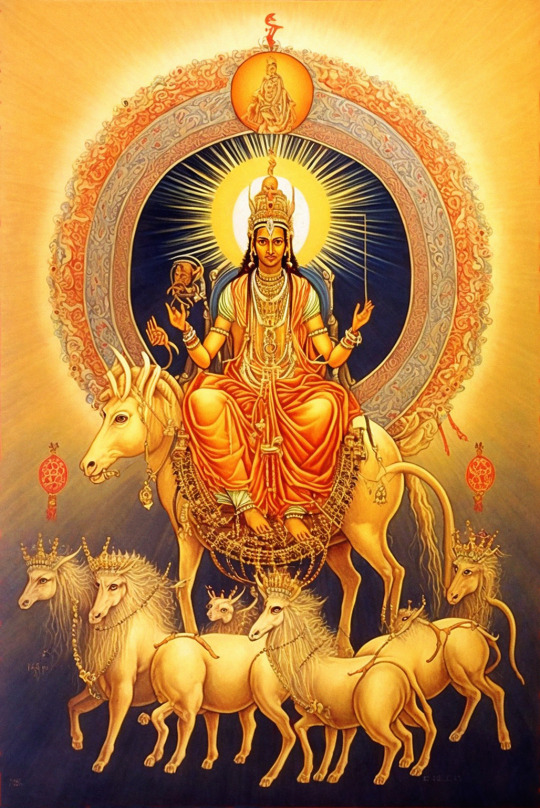
Lord Surya and his Chariot ☀️
Talon Abraxas
Symbolism And Significance Of The Seven Horses Surya - Sun God in Hinduism
Lord Surya is the sun god in Hinduism. Important scriptures and mythology associated with Hindu religion contains several depiction of Lord Surya riding seven horses. The seven horses are known as Harits. Ratha Saptami is an important festival dedicated to Lord Surya riding seven horses.
In Hindu Mythology, Lord Surya rides across the heavens (sky) in a chariot drawn by seven horses. The horses symbolize the cosmic rays, which radiates warmth and life. As they move across the skies, they remove darkness and usher in light. The seven horses also symbolize the seven colors of rainbow.
The reins of the horses are firmly in the hands of Aruna (Charioteer of Sun God). The reins are the seasons and Aruna makes sure with the reins that rays of the sun sustain all living beings. The seven horses are also said to represent the seven days of the week.
The seven horses are often referred as Harits and sometimes instead of horses it is seven mares. Occasionally, they are also depicted as one horse or mare with seven heads.
13 notes
·
View notes
Text
The Horses of Sun God’s Chariot as Revealed in the Sanātana Dharma
The Horses of Sun God’s Chariot as Revealed in the Sanātana Dharma
Dr. Raghava S. Boddupalli
Beginning with the Vedas, Smṛtis, Purāṇas, Mantra Śāstras, the complete Stōtra Vāṅṃaya are the combined pillars of the Sanātana Dharma. It is eternal and never-changing. Āditya (the Sun God) is one of the Vedic deities who received sufficient attention in all the Veda-Saṃhitas, Brāhmaṇas, Āraṇyakas and Upaniṣads (Table 1).
Veda…
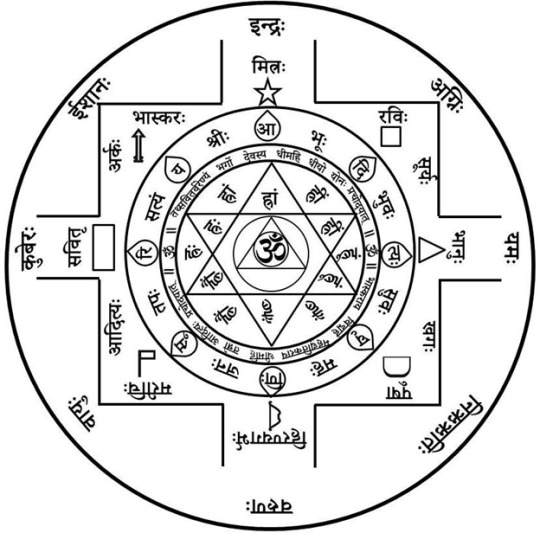
View On WordPress
#Aditya#Culture#Hiranyagarbha#Philosophy#purana#Rigveda#Sanatan Dharma#Surya#Taittiriya Aranyaka#Vedas#Vedic#Yajurveda
2 notes
·
View notes